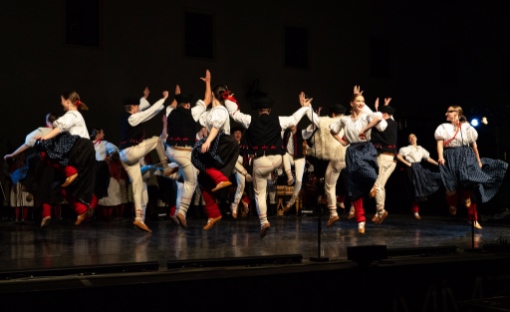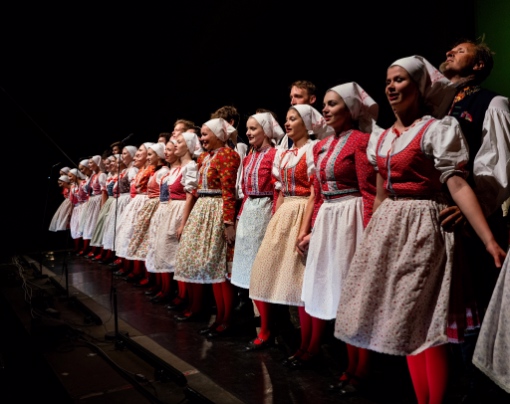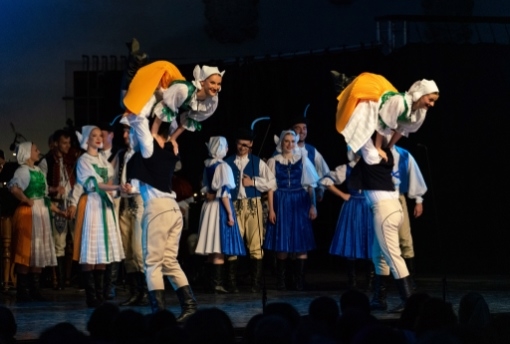For the fourth year in a row, audiences could visit the courtyard of Špilberk Castle and enjoy the dance art of the Ondráš Military Art Ensemble from Brno in a series called Evenings with Ondráš. This year, on the two days of 15 and 16 June, those interested once again saw the best that the company currently has to offer. Moreover, the concerts were fundraisers, with the money raised going to the Military Solidarity Fund. I will take a look at the second, Friday evening, during which Ondráš invited his friends from the Mladina ensemble of Pilsen to the stage.
The whole concert was conceived as a train journey across the Czech Republic and Slovakia. Zdeněk Sklenář served as the narrator and guide for the evening on this imaginary folklore express. The host’s (or conductor’s) words may not have caused fits of laughter among the audience, but they were certainly tasteful, witty and appropriate.
The Ondráš Orchestra presented itself in a relatively new line-up, only half a year old. Dominik Orság, likewise from Wallachia, replaced Štěpán Blinka as band leader. However, other instrument sections have also seen changes. For instance, former double-bassist Ondřej Vinkler replaced Róbert Lacko, a long-time member of the orchestra, at the cello. He was replaced on the bass by Kamil Kristen, a seasoned musician from Brno, who you might know from earlier years from Púčik ensemble, for example. There was also a new face behind the dulcimer, played by Michal Baláž. Michal Trkan joined the violin section in lieu of the new band leader.

The orchestra was in its usual excellent form, both as accompaniment to the dancers and in the solo pieces. Perhaps my only comment would be that some of the orchestra’s stalwarts showed somewhat less passion than their newer colleagues. The only exception is Věra Špačková, whose smile is as disarming and sincere as ever. This is a small certainty, which I always look forward to.
Ondráš gave seven performances, largely of their older pieces. The only choreography we haven’t yet had a chance to see from Ondráš was Trnky. However, this is not a new number in the true sense of the word. The choreography was created about thirty years ago by Libuše Hynková. The age of the dance was evident. I am not a big advocate of repeating the same stereotypes and this choreography is full of them. The observed age not only excuses this, but even makes the dance a charming curiosity. Where else would we have the opportunity to compare the style of past and present choreographers than here in Ondráš’s technically excellent performance.
Another number, which requires acting skills in addition to thorough dance training, was the Na salaši dance. I usually enjoy dance acts more than theatrical ones, but this piece is a nice exception. Its originality and whimsicality still amuses and evokes a smile. It should be noted that the current cast of the dance component handles the acting passages with aplomb.
Other performances by Ondráš included the obligatory Myjava, but also the well-known musical number Klobučtí primáši.

Ondráš’s performances alternated with six dances by the Mladina ensemble. Although this ensemble from Pilsen is completely amateur, it stood up to its host in terms of its dance readiness and the technical sophistication of individual numbers. You can really see that they’ve got the regions and typical Czech swaying in their blood. Na tři strany displayed an interesting choreography, allowing a comparison of traditional costumes from Doudleby, Postřekov and Chrudim. I was also amused by a dance from Old Prague titled Do hospody (To the pub).
Mladina’s music uses traditional instruments and the musical arrangements are created with sensitivity towards the original material. Although Ondráš managed to rehearse the character of Czech dancing and singing very believably, it was clear from the singing that they are not local. However, if I hadn’t had a direct comparison with Mladina in the last dance of the evening, I wouldn’t have thought to mention it.
The only thing that made a really successful program slightly unpleasant was the cold. The metal chairs, which are not very comfortable and are quite cold, only accentuated the audience’s discomfort. Moreover, the program was quite long. But let’s leave the vagaries of the weather aside. I am delighted to have experienced a good concert, where two ensembles in top form performed. What more could you ask for at the beginning of the festival season?
































No comment added yet..